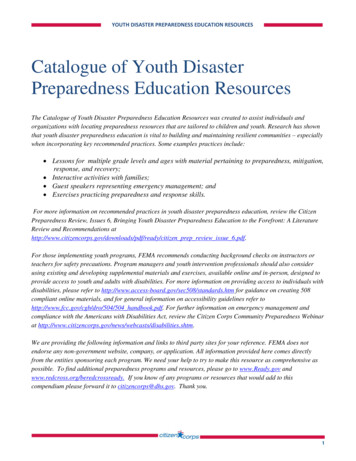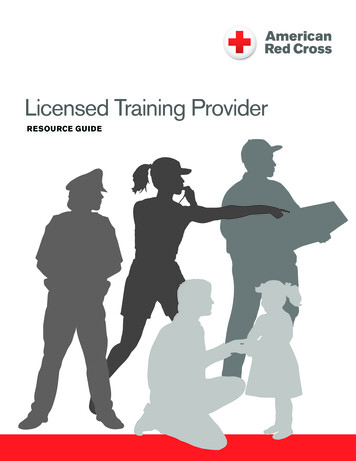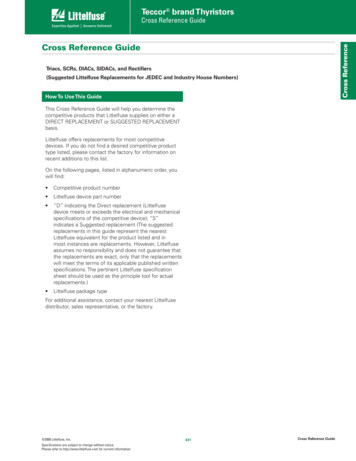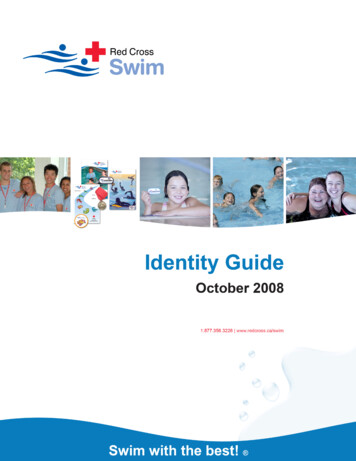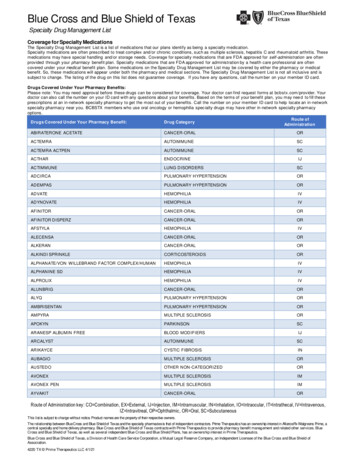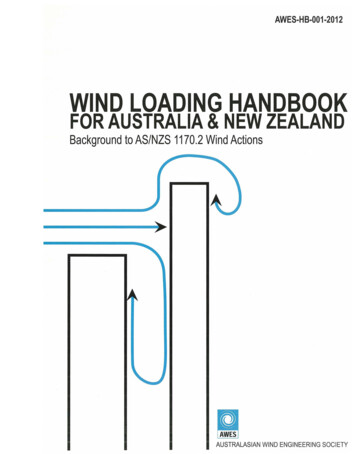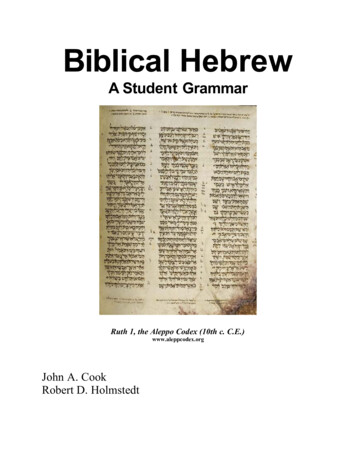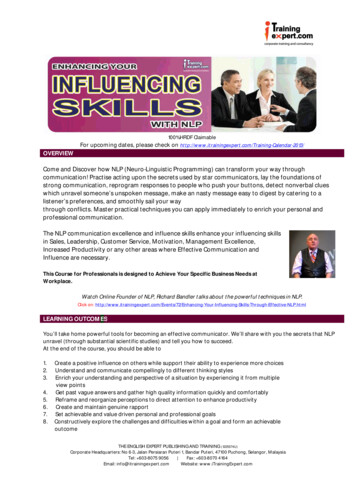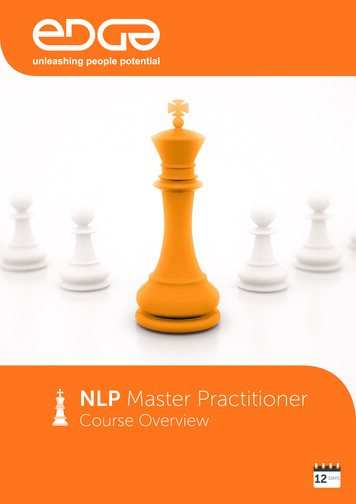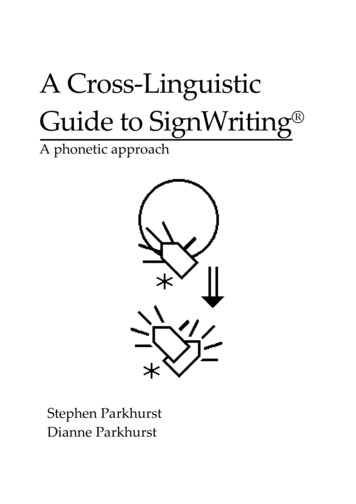
Transcription
A Cross-LinguisticGuide to SignWriting A phonetic approachStephen ParkhurstDianne Parkhurst
A Cross-Linguistic Guide to SignWriting :A phonetic approach 2008 Stephen ParkhurstRevision 2010For use at SIL-UND courses during the summer of 2010.All rights reserved. No part of this publication may be reproduced, stored in aretrieval system, transmitted or utilized in any form or by any means, electronic,mechanical, photocopying, recorded or otherwise, without permission from theauthors.Stephen and Dianne ParkhurstE-mail: steve-dianne parkhurst@sil.org
A note from the authorsSignWriting , also known as Sutton Movement Writing for Sign Language, wasinvented by Valerie Sutton in 1974. Over the years the system has changed significantlyand has gradually grown in acceptance and popularity in more than 30 countries. Whilethere are other writing systems and notation systems for writing signed languages, wehave not found any system that is as useful for writing accurately any sign or movement(including all non-manual movements and expressions) with relative ease and speed. It isalso the only writing system that we have tried that is possible to read faster than one canphysically produce the signs (outpacing even photos and line drawings in ease and speedof reading).We have taken much of the material for this manual from a course we developedfor teaching SignWriting (SW) to Deaf adults in Spain. That course in Spain focused onteaching the symbols of SW that are used in Spanish Sign Language (or LSE, for Lenguade Signos Española) with a heavy focus on reading. It was developed as a 30-hourcourse, in which the students were not expected to do much homework and much of thein-class time was spent reading stories in LSE. The material was designed so that thesimplest and most common symbols were introduced first.This manual differs from the original course materials in several ways. This is acourse for field linguists, not for Deaf signers of one particular language. As a result, thisbook introduces a larger number of symbols with a focus on understanding the principlesbehind the symbol formation. While this manual teaches far more handshapes than arelikely to appear in any given signed language, even so it is not an exhaustive study; it isalmost impossible to teach all the potential handshapes from all the signed languages ofthe world. However, any handshape can be represented accurately, once one understandsthe principles behind symbol formation.This course primarily focuses on the phonetics of writing rather than thephonology. In other words, we focus on details of a sign and not on how to simplify thewriting to reflect the system of a particular language. For example, in many languagesthere may not be a meaningful distinction between a handshape with the thumb extendedand the same handshape with the thumb folded over. However, here we will teach all thesymbols and leave the task of consolidating non-distinctive symbols for the phonologistsand literacy specialists.The literacy courses in Spain did not expect the students to do a lot of workoutside of class. Those courses also focused primarily on reading with less emphasis onwriting. Here, many more symbols have been added to the manual. As a result, thestudent will be expected to do work outside of class, both studying this manual as well aslots of writing practice. The goal of this course is, that by the end, students will be able tosit down in a language-learning situation and accurately and quickly take notes aboutwhat they are learning. To reach this level, students will need to put forth a significanteffort. As with many skills, “practice makes perfect.”While the original course placed a heavy focus on non-manuals (e.g., facialexpressions and head and body movements), this course is primarily interested in writingindividual signs. Non-manuals will be introduced in units 10 – 12. This focus on themanual elements of the sign does not mean that non-manuals are not important or thati
this writing system is somehow incapable of representing the rich non-manual structuresof signed languages. On the contrary, SW has a very extensive set of non-manualsymbols capable of recording the intricacies of non-manual movements. However, due tothe limitations of this course, we will leave many of the intricacies of non-manuals fordiscussion in the phonology and syntax courses (although the symbols will be presentedhere).While this course is not a literacy course, we have tried to maintain some of thesame basic principles, such as starting with the most basic concepts and most commonsymbols and gradually moving toward the more difficult and more obscure.The examples in this book come primarily from Spanish Sign Language (LSE)unless specifically marked otherwise. We have purposely chosen this language becausemost users of this book will not know LSE. One of the primary goals of this course is thatthe students develop the skill of seeing a sign or phrase that they have never seen before,copy it accurately with their hands, and then write it down (see it, do it, write it).This is not a literacy course. We will not discuss issues such as how to designliteracy materials or which set of symbols should be used for a particular language. Norwill we discuss the sociolinguistic implications of introducing or using a writing systemin a Deaf community. Likewise, we recognize that there are other writing systems outthere. We have chosen SW because it is best suited for our purpose of writing quicklyand accurately in a field situation. Although there are several computer programsavailable that use SW, we will focus on handwriting. Computer programs will probablychange significantly in the next few years but the writing system will likely remain fairlystable.We hope you enjoy this course and find it useful.June 11, 2006Steve and Dianne ParkhurstBook updated June 4, 2010ii
Table of contentsUnit 1Observer’s perspective and signer’s perspectiveHand orientations (with the flat hand)Contact symbol: touchOther basic handshapesThe head, arm/wrist123568Unit 2Hand orientations: top-down point of viewStraight up-and-down movements; basics about movementContact symbol: brushSome basic handshapesStraight forward-and-back movements91015181922Unit 3Handshape anatomy: the thumbSigns that touch the body, arms and faceChanges in handshape and orientation27283138Unit 4Handshape anatomy: pinky, middle and ring fingersComplex straight arrowsStraight movements on the “side-wall” planeBasic punctuation3940424346Unit 5Handshape anatomy: hooked fingersCircular movementsContact symbols: rub, hold, in-between and strike47485256Unit 6Handshape anatomy: bent handshapesFinger movement596063iii
Unit 7Handshape anatomy: mixed handshapesArcs on three planesTouching the ear or hair71727681Unit 8Handshape anatomy: C, E, and LSM handshapesComplex arcsPosition symbols83848789Unit 9Handshape anatomy: under, over, crossed and stackedArm twistsSerial movements919296101Unit 10Handshape anatomy: degrees of bendingSide view and top-down view of the bodyWrist movements103104107109Unit 11Introduction to non-manual elementsEyebrowsPunctuation: phrase marking, questions, and quotesHead and body movementDynamic symbols and classifiers113114115115119124Unit 12Eyes: aperture and eye gazeNoseMouth: jaw, lips, teeth, cheeks and tongueAir flow127128130131137Topical index139Appendix: Partial List of Symbols141iv
Unit 1Contents: Observer’s perspective and signer’s perspectiveHand orientationsContact symbols: touchSome basic handshapesThe head, arm/wristUnit 11
Two perspectivesObserver’s perspectiveWhen another person signs to you,you see his hands. You are anobserver.This is called the “observer’sperspective” or receptiveviewpoint.Signer’s perspectiveWhen you sign to someone, you see yourown hands. You see the signs from yourown perspective.This is called the “signer’s perspective” orexpressive viewpoint.SignWriting is based on the signer’s perspective—how you see your ownhands when you sign.2Unit 1
Hand orientationWhen you read and write a sign, you write itthe way you see your own hands.The palmIf you can see the palm of yourhand as you sign, the symbolthat represents the hand will bewhite (or not shaded). On achalkboard, it will be a hollowsymbol outlined with chalk.The back of the handWhen you see the back of yourhand, the symbol thatrepresents the hand will beblack (or shaded). On achalkboard, it will be the colorof the chalk, which may bewhite.The side of the handWhen you see the side of yourhand, the symbol for the handwill be half white, half black.The white/unshaded part of thesymbol shows which directionthe palm is facing. Theblack/shaded part of the symbolshows which direction the backof the hand is facing.Unit 13
The left handThe right handRotating the handYou can turn the symbol in any direction.4Unit 1
Contact symbol: TouchSignWriting includes symbols that tell what kind of contact the hands makeduring the sign. This is the first contact symbol:TouchAn asterisk is used to mean touch.The touch symbol is used when the hands touch each other or some part ofthe body.Try to read these signs:The touch symbol is placed near where thetwo hands touchTIME OUTHOUSEPlace two (or more) touch symbols toshow that the hands touch two (or more)times.In a symmetrical sign, both hands moveslightly to repeat the contact.If the sign is not symmetrical, thedominant hand usually moves.APPLAUD (hearing people)MINIMUM (LSC)Unit 15
New handshapesThe closed fistThe closed fist is written as asquare.If, when you sign, you see thepalm of your hand, the symbolused to represent it will bewhite.CARIf you see the side of yourhand, the symbol will be halfblack and half white.FULLIf you see the back of yourhand as you sign, the symbolwill be black.WASH6Unit 1
This square with one line extendingfrom the corner represents the fistwith the index finger extended.If, when you sign, you see the palm ofyour hand, the symbol used torepresent it will be white.ALONEIf you see the side of your hand, thesymbol will be half black and halfwhite.LAWIf you see the back of your hand asyou sign, the symbol will be black.NOUnit 17
The head, arm/wristA circle represents the head. You have to imagine that you are seeing yourown head from behind you.When you are signing with your right hand close to or touching the rightside of your head, you write the symbols for the hand and the contact at theright side of the circle, overlap the hand and the head, or write the contact onthe head itself:GRANDFATHERThe bar attached to thishand represents thewrist or arm. It helpsshow clearly whichpart of the fist istouching under thechin. The arm barconnects to the centerof the bottom of thehand; here, it’s at a 45ºangle from the hand.AGE8DEAFCONFESS (to a priest)Unit 1
Unit 2Contents: Hand orientations: the “top-down” point of viewStraight up-and-down movementsContact symbol: brushSome basic handshapesStraight forward-and-back movementsUnit 29
Two points of viewForward viewHand parallel to the front wallWhen the hand is vertical/upright, orparallel to the front wall, it’s easy tosee what its configuration is whenlooking from the forward point of view.But when your hand is horizontal, orparallel to the floor, it’s hard to seewhat its configuration is from theforward point of view.What can we do?Top-down viewHand parallel to the floorBecause it’s hard to see its configurationfrom the forward point of view, when yourhand is parallel to the floor, you write it asif you were seeing it from above.10Unit 2
A small gap between the symbol for thehand and the symbol(s) for the fingersmeans that the hand is parallel to the floor.You pretend to look down on it.This symbol can be rotatedin all directions too.Remember: this symbol means that the hand is parallel to the floor. Itdoesn’t matter if you can actually look down on it or not.andare written:Unit 211
We’ll look at some examples of configurations that we already know, butthis time they’ll be written from above, parallel to the floor.The gap between thehand and the fingersmeans that the hand isparallel to the floor.UNCLESAMENote that these twosymbols represent thesame orientation:12Unit 2
When the hand has nofingers extended, the gapis at the level of theknuckles. The gapmeans that the hand isparallel to the floor.IMPORTANTCOMPANIONTABLENote that these twosymbols represent thesame orientation:Unit 213
The gap at the level ofthe knuckles means thatthe hand is parallel to thefloor.COLDWhen one handtouches the oppositewrist or arm, we use aline to represent thearm. The contactsymbol is written closeto the point of contact.Note that these two symbols representthe same orientation:14Unit 2TIME
Movement arrowsUp-down movementsUp-down movements are parallel to an imaginary wall in front of the signer,on the vertical plane.They are written with double-stemmed arrows:VerticalStraight upDiagonallyup and tothe leftDiagonallyup and tothe rightto the leftto the rightDiagonallydown and tothe leftDiagonallydown and tothe rightStraight downUnit 215
Left- and Right-hand movementsLeft-hand movementsRight-hand movementsWhen the arrow head is white, itmeans that the left hand moves:When the arrow head is black,the right hand moves:In the following example, only theleft hand moves.In this example, only the righthand moves.16Unit 2
Examples of signs that use one hand:SHORTNOFATHERIn the examples below, each hand moves several times. When there areseveral arrows for each hand, we read the sign’s movement from the centertoward the edges or from the top to the bottom.Examples:TO WEIGHCARTO ARGUESometimes seeing all those arrows can be confusing. Onesimple tool to help us remember where to start reading thearrows is the one written at the right, called a tie. The tie helpsus remember that these two arrows are “tied together” andtheir movements are simultaneous, happening at the same time.Examples:17Unit 2
Contact symbol: brushBrushThis type of contact is written as a circle with a dot in the center.Brush is a light contact in which the hand slides across another surface andthen separates again.Examples:NIGHTOCTOBERMORNINGLESSONUnit 2TO GOCARING18
More handshapesHandshape:Is writtenlike this:Example:BLACKPERUPARLIAMENT (LSC)THIRD19Unit 2
Handshape:Is writtenlike this:Example:PROGRAMBARCELONAOBEYSIGNUnit 220
Handshape:Is writtenlike this:Example:TUBEJUSTICECELL PHONENote that these handshapes have a circular base. The circlebase is only used in handshapes where the circular form ofthe fingers is important. In many languages, these twohandshapes are interchangeable; even when the base isrelaxed, forming a circle, signers do not view the circular form as importantto the meaning of the sign. In other languages, these handshapes are viewedas distinct and the form of the base is important.21Unit 2
More movement arrowsForward-and-back movementForward-and-back movement is movement that is parallel to the floor.It is written with single-stemmed arrows:Horizontal planeStraight forwardDiagonallyforward andtoward the leftDiagonallyforward andtoward the rightto the leftto the rightHorizontal planeStraight backDiagonallyback andtoward the leftDiagonallyback andtoward the rightUnit 222
Up-down movementForward-and-back movementNote the difference between these pairs of signs:STAND UP, EVERYBODYTO HELPUP23YOUUnit 2
Remember: these groups of arrows represent movements on two planes:Movements that are parallel to thewall, or up-and-downMovements that are parallel tothe floor, or forward-and-backWhen the two planes overlap, some arrows on each plane represent the samemovements toward the sides.Unit 224
Straight movement toward the sides can be written using double-stemmed orsingle-stemmed arrows. The arrows below represent the same movements:These double-stemmed arrows are the same as these single-stemmed arrows.The sign TABLE can be written either way:ORThey are exactly the same.Examples of single-stemmed arrows:TO MEET25LESSONTO EXPLAINUnit 2THEATER
Both hands move as one unitThere are times when the two hands move together as a single unit.Sometimes the use of a separate arrow for each hand becomes confusing andit is difficult to know where to put the arrows. This usually happens whenthe two hands are touching each other or they follow the same trajectory. Inthese cases, we use a special kind of arrow head:We call this an “open” arrow head (it is neither black nor white), and itmeans that both hands move together as one unit.Examples:TRUCKTO DISCRIMINATEAGAINSTTROPHYBABY(from two perspectives) BABYUnit 226
Unit 3Contents: Handshape anatomy: thumb Signs that touch the body, arms and face Changes in handshape and orientationUnit 327
Handshape anatomy: thumbAs we have already seen, an opposed flexed thumb that is holding down theother fingers is usually not written.These thumbs arewritten:When the unopposed non-extended thumb is up to the side together with theother fingers, it looks like this:An exception to thisrule is the “flat” or“open” handshape:When the unopposed extended thumb is out to the side, it looks like this:Notice that from theside view, the thumbextends from theblack part of thehand.28Unit 3
When the opposed non-flexed thumb is straight forward, it looks like this:Notice that from theside view, the thumbextends from thewhite part of thehand.Some new handshapes that follow these rules:Examples:CLUB MEMBERRENAULT (car mfgr.)HOTELRECEIVE RECOGNITIONUnit 3ELEVATORLAW (LSC)29
Examples:MISCHIEVOUSAPPLEFROM NOW ONNote: These three handshapes are often allophones; i.e.,the thumb’s position does not change the meaning of thesign. If the thumb position is not important, most writerschoose to write the second HS, leaving the first and thirdsymbols for those situations when the thumb postion isimportant. Until you have studied a language longenough to know what’s important, write all details.30Unit 3DOORBELLExample:CHURCH
The bodySometimes the hands touch the body. When one hand touches the center ofthe chest, we write the contact symbol under the hand symbol.MEMYTO FEELWhen the hands touch one side of the chest or the shoulders, this heavy barrepresents the shoulders. This bar is also used when the hands are close toone side of the body without touching it.ELEGANTVACATIONUnit 3TO GO HUNTING31
The hipsThe second bar represents the hips. When the hands move near the waist,touch the waist or some part of the body near the waist, we write two bars(the top one represents shoulders and the bottom one, hips) and place thehands in relation to the hips. Note that a single horizontal bar alwaysrepresents the shoulders. You must write two bars if you refer to the hips.GOVERNMENT(LSM)DOG (LSE, inLa Coruña)SKIRTThe armWhen the hand touches anywhere on the arm, we use a long line to representthe arm. If the focus is on the wrist or forearm, the arm bar is attached to thehand. If the point of contact is the upper arm, it is attached to the shoulder.The line must be long enough so that it will not be confused with a finger.CAPTAIN32STINGYUnit 3SHORT SLEEVES
Back of head, back, and buttocksThese curved lines are written at the sides of thecircle that represents the head to show that the handis behind the head.back of the headRemember that your perspective doesn’t change:just as the height of the hand (page 11) does notaffect your ability to write it as if you are seeing itfrom above, so the position of the head does notchange the hand’s orientation. In these twoexamples, the orientation of the hand is the same:in the first, the back of the hand is touching theface; in the second, the palm of the hand touchesthe back of the head.12PONYTAILHYPOCRITEThis same principle can be used for showing the back and the buttocks.BACKHAMUnit 333
The faceMost of the time the hand (number 1 below) or the touch symbol (number 2)can be placed directly on the head symbol to show contact with theforehead, temples, cheeks, jaw and chin. Other times, piling up symbolsbecomes confusing. Another option is to place a scoop (number 3) on thepoint of contact, and place the hand and other symbols nearby.123These three options for the sign GERMANY all represent the thumbtouching the forehead. Option 1 is a bit unclear due to the overlap of thesymbols. Option 2 could be misunderstood as touching two separatelocations on the forehead. Option 3 uses the “scoop” to show the locationand the touch symbol to show that it is the thumb that touches the forehead.Examples:Note: thissign doesnot touchthe chin, butit is signeddirectly infront of thechin area.DIRTY34BELIEVEDIALOGUEUnit 3
When the hand touches the perimeter of the face, we do not use the scoop.This includes signs that touch the top or side of the head, and under thechin.LEADER (LSC)UPSETOH, NO!The neckThis is the symbol used to represent the neck, toshow that the hands touch or are close to theneck.the neckTO LOSESINUnit 3REPULSIVE35
The eyes and eyebrowsWhen the focus of a sign is the eyes, or when thepoint of contact is the eyes or near the eyes, wewrite small semi-circles to represent (open) eyes.Examples:TO SEEEYESWhen the point of contact is the eyebrows, we use thissymbol. (Later we will introduce facial expressionsthat include raised and lowered eyebrows.)JOSE MARI (name sign)36Unit 3GARLIC
The nose and mouthWhen the nose is the point of contact for a sign, ashort vertical line down the center of the facerepresents the nose. The contact symbol can bewritten on the nose line, on the face near it, or off tothe side of the face, whichever is clearer or moreexact.Examples:TWO YEARSWINEMAN (LSC)When the mouth is the point of contact or thefocus of a sign, a short horizontal line is used torepresent the mouth. (Later we will see that thereare many mouth symbols used to represent thefacial expressions and mouth patterns.) Thesimple horizontal line is the neutral mouth symboland is only used as a point of contact.QUIETCIGARUnit 3TO SMOKE37
Changes in handshape andorientationsWhen a sign starts with one handshape and ends with another, if it is notobvious what the second one will be, we write both the initial and the finalhandshape. To read the sign, start with the handshape that is closer to thestraight end of the arrow, and move the hand toward the arrow head. If thereare no arrows that indicate which symbol is read first, we read from top tobottom and left to right.DANGEROUSFAMOUSTWENTYWhen a sign starts with one orientation and ends with another, if it is notobvious what those orientations will be, we write both the initial and thefinal orientations.TABLE38TO KNOWUnit 3EXPERIENCE
Unit 4Contents: Handshape anatomy: pinky, middle and ring fingersSome complex arrowsStraight movements on the “side-wall” planeBasic punctuationUnit 439
Handshape anatomy: pinky fingerThe pinky extends at a 45-degree angle from the corner of the base. Noticethat on the side view, the pinky extends from the white corner.TO HAVE FUNMore pinky handshapes:NEAR40MISTAKEAIRPLANEFLY OVER (ASL)Unit 4PIPE
Middle and ring fingersThe middle finger is longer than the index and extends at a 90-degree anglefrom the center of the base. The ring finger is shorter than the middle fingerand is usually placed between the corner and the middle of the base. Theexception to that rule is when only the ring and pinky fingers are extended.ARMY TANKTATTOOFIGHTER JETNote: the arm bar is thicker and longer than the middle finger. As inTATTOO, when the orientation of the hand is awkward, it may be necessaryto write both arms to make it clear which hand is the dominant hand.YOUNGER BROTHER(Hong Kong SL)FIRSTUnit 4SECONDTHIRD41
More movement arrowsWe can write more complex movements on the two planes (the front walland the floor) using the single-stemmed and double-stemmed arrowconvention that we use for straight arrows.HAPPYDENMARKRED CROSSSQUARE SHAPE42Unit 4INTERNATIONALREADCANCELSQUARE SHAPE
More straight movementsWe have already seen straight arrows on two different planes (1 and 2):Plane 1 (x,y): parallel to the front wallAll these movements are written withdouble-stemmed arrows.Plane 2 (x,z):parallel to the floorAll these movements arewritten with singlestemmed arrows.Plane 3 (y,z):parallel to the side wallThe four movements shown at left are taken from theother two planes.But what about diagonal movements on this plane?Unit 443
A horizontal line written across an up or down arrow is used to representstraight movement that moves away from the signer, up or down. The linecan be thought of as representing the distant horizon. The horizontal line isclose to the head of the arrow to show that the end point of the movement isaway from the body (toward the horizon).112ADVANCE44up and towardthe horizonTO KILLUnit 42down and towardthe horizonEXPLOSION
A black dot written between the lines of an up or down arrow is used torepresent diagonal movements that move closer to the body in a straightdiagonal line. The black dot is closer to the head of the arrow to show thatthe endpoint of the movement is closest to the body. Note that the black dotdoes not imply that the hand actually touches the body. The dot is only usedas a relative point of reference.112BED SHEETS2down andup and towardtoward the bodythe bodyRESCUEUnit 4GRACE45
Basic punctuationPunctuation is mostly used for writing texts, not for phonetic transcription.However, a few basic punctuation marks are useful.The symbol that corresponds to a period can be viewed as a long pause or acompletion of an idea. At this point signers usually blink and might put theirhands in a neutral postion briefly.The symbol that we use for a comma refers to a short pause, sometimeswhile a signer mentions a list of items. We will introduce the full range ofpunctuation later in this course.When we write a complete sentence, we finish thesentence with this symbol, which represents a period:Two thin lines represent a comma. We use commasbetween items in a list or between related ideas.The use of commas helps us visually separateone idea from another.HOUSETHERE AREMYSMALL/NARROW3 LEVELSBUTTHREE (long pause)“My house is narrow but tall, it has three floors.”46Unit 4TALLTALL (pause)
Unit 5Contents: Handshape anatomy: hooked fingers Circular movements Contact symbols: rub, hold, in-between and strikeUnit 547
Handshape Anatomy: “hooked”fingers“Hooked” handshapes refer to handshapes that flex the finger joints(phalangeal joints). Notice which direction the fingers hook when the handis rotated. On the front and back orientations, the fingers curl toward the partwhere the thumb would be. On the side view, the fingers curl toward thepalm.The thumb (when flexed and unopposed) always curls upward.48Unit 5
Thumb to the side (flexed, unopposed) vs. thumb forward (opposed):Note: The index fingeris turned away fromthe thumb on the frontand back views. Thishelps us see that theindex and thumb arenot on the same plane.Compare this with thenext three handshapes.Note: On the thumbforward handshapes,the index comes out ofthe top corner on thesame side as thethumb. This showsmore clearly therelative size of the gapbetween the thumband fingers.Note: The gap can belarger or smaller thanthe normal gap. Manysigned languages don’tmake this gap sizedistinction except inclassifier constructionswhere the exact gapcorresponds to a reallife measurement.More hooked handshapes:Unit 549
Notice: this lasthandshape has adifferent baseshape. We will seemore examples ofthis kind of base inthe next unit.More handshapes:Degree of finger flex:The degree of flexing may not becontrastive in some languages.However, the less-hooked symbol ismore accurate when the point ofcontact is the tip of the index finger.Examples:ANTIQUE50JUNETO COMEUnit 5JUNE (LSC)
More examples:TELEGRAPHDOUBTLAUGHTERTOWNTO AGREE TO MEETDEERENEMYTO INSULTPIZZACOOKIEGROUPUnit 5KINGENGLISHSLEEP (LSC)51
Circular MovementSignWriting has arrows for various kinds of circular movements. This firsttype of circular movement starts at the elbow; the forearm and hand move asa unit with no wrist rotation. The arrow head shows the direction of themovement and the number of circles; it may also show the place where themovement starts. We will look at this type of movement on three planes.Plane 1 (x,y)Circular movementWhen the hand moves in a circle on the same plane as the front wall, themovement you would use to wash a window, the movement is written withthis arrow (plane 1).This circular movement is always the same distance from the body.TO LOOK FOR52OPINIONWASHING MACHINEUnit 5
When the hand moves in a circle in a movement like you would use to washa table with a cloth, this movement is written with this arrow (plane 2).Plane 2 (x,z)Circular movementThe arrow stem is thicker when the hand is closer to the body and thinnerwhen the hand moves farther from the body.ALONEOILBOSSUnit 5AUGUST53
Plane 3 (y,z)Circular movementWhen the hand moves in a circle, the same movement used for rowing aboat, the movement is written like this (plane 3).The arrow stem is thicker when the hand is closer to the body and thinnerwhen the hand is farther from the body.CULTURE54GOOD AFTERNOONUnit 5LONG AGO
Two-handed movementsWhen a movement is written for both hands, this tie symbolunites the movements to indicate that that both hands move at the sametime. The movement is simultaneous.NOTHINGDEFENDALWAYSWhen the circular movement is written for both handsand the hands alternate, this symbol is used to show thatthe hands alternate as they circle. To make it clearer thatthe hands are alternating, the hands and circle symbolscan be slightly offset from each other.BICYCLEPROBLEMUnit 5DOMINOES55
Contact symbol: rubRub (in a circle)The motion of rubbing in a circle is written with a spiral.A rub is when your hand makes circular cont
The examples in this book come primarily from Spanish Sign Language (LSE) unless specifically marked otherwise. We have purposely chosen this language because most users of this book will not know LSE. One of the primary goals of this course is that the students develop the skill of seeing a
